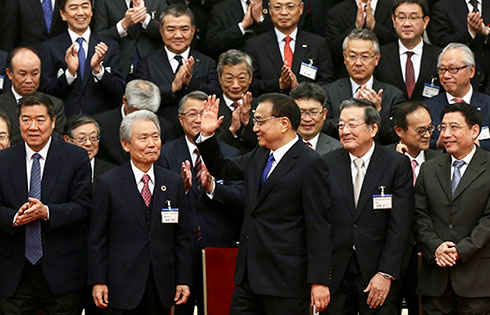China-US S&ED Outcomes of the Strategic Track
III. Sub-national Cooperation
38. Building Sub-National Relationships: Decided to continue to enhance sub-national relations as envisioned in the Memorandum of Understanding (MOU) Concerning the Establishment of the US-China Governors Forum to Promote Sub-National Cooperation including the Governors Forum held in April 2013 in Beijing and Tianjin. There are over 200 sister-city/sister-state relationships between the United States and China, and both sides welcome new sub-national relationships that foster innovation, create new business opportunities, and expand people-to-people exchanges. Representatives from both countries participated in the China International Friendship Cities Conference held in September 2012 in Chengdu, where they witnessed the signing of the MOU between Sister Cities International (SCI) and the Chinese People’s Association for Friendship with Foreign Countries (CPAFFC). This MOU formalized the ongoing partnership to collaborate to create new sister-city and sister-state/province relationships between U.S. and Chinese communities to promote mutual understanding and prosperity in their respective communities. SCI and CPAFFC are working together to plan the U.S.-China Sister Cities Conference in 2014 in the United States.
39. EcoPartnerships: Held a signing ceremony, witnessed by Deputy Secretary of State William Burns and State Councilor Yang Jiechi, during the 5th S&ED and admitted six new EcoPartnerships. The two sides held a conference in December 2012 and launched a new website in 2013 focused on improving information sharing and transparency and facilitating cooperation among EcoPartners. By bringing together US and Chinese local governments, research institutions, universities, corporations, and non-governmental organizations, EcoPartnerships spur innovation, investment, and cooperation on energy and environmental issues in both countries. Critical investment by and pragmatic cooperation among EcoPartners at the sub-national level translate the strategic goals of the Ten-Year Framework action plans into concrete achievements.
40. EcoPartnerships Workshop: Decided to hold an EcoPartnerships Workshop immediately after the 5th S&ED. The attendees will exchange experiences and practices in developing successful green cooperation projects and discuss how the EcoPartnerships program, as an effective platform of promoting pragmatic cooperation in energy and environment areas, should continue to make contributions to US-China cooperation on green and low-carbon development.
41. Eco-City Project: Announced six pilot eco-cities. Based on an annex signed in 2011, DOE and the Ministry of Housing and Urban-Rural Development (MOHURD) jointly created this project to study and develop comparative eco-city guidelines and standards, determine technology and deployment needs, and assess the effects and best practices in sustainable urban development.
42. Mayors Training Program: Welcomed the fourth Chinese mayors delegation to the United States in June 2013. The second US mayors delegation is scheduled to visit China in September 2013. This program, initiated in 2010 by and U.S. Department of Energy (DOE) and Ministry of Housing and Urban Development (MOHURD) with support from the US Trade and Development Agency (USTDA), has brought mayors from both countries together on training trips in the United States and China to examine best practices in eco-city development and to promote exchange of ideas and promote deployment of green technologies.
IV. Cooperation on Energy
43. Energy Security: Reaffirmed the commitments made in the US-China Joint Statement on Energy Security Cooperation, which noted the two countries, as the world’s largest producers and consumers of energy, share common interests and responsibilities to ensure energy security and face common challenges. The United States and China discussed ways to diversify their sources of supply and further develop domestic energy resources to meet growing demand needs. Both sides recognized our shared goal of working to strengthen global energy security. The United States and China commit to continuing to discuss Chinese concerns about energy security and energy demand. The United States and China pledged to strengthen cooperation and increased dialogue and exchange of information in several areas including stabilizing international energy markets, emergency responses, ensuring diversified energy supply, and a rational and efficient use of energy.
44. Energy Transparency: Welcomed China’s commitment to continue improving the transparency, timeliness, completeness, and reliability of energy data based on its G-20 commitments. China commits to carry out studies on oil and natural gas geologic reserve data and release the data publicly. The United States and China commit to strengthen exchanges and communication and to expand cooperation in oil inventory policies, management and technologies.
45. Legal and Regulatory Framework for Unconventional Oil and Gas: Welcome China’s decision to accelerate the development of the legal and regulatory framework covering unconventional oil and natural gas. The framework is expected to: (1) include better coordination among the relevant agencies; (2) include regulatory incentives to build natural gas infrastructure (e.g., treatment facilities and pipelines); (3) include measures to move toward market-based natural gas pricing to promote domestic production; (4) include stronger regulation over fugitive methane emissions during production and distribution of natural gas and water usage during production; and (5) welcome foreign companies to participate in China’s unconventional oil and gas industry following commercial principles. In order to speed China’s progress toward cleaner fuels and reduce emissions in power generation, the United States and China decided to actively promote technical and environmental protection cooperation in unconventional energy resources such as shale gas, including through a series of shale gas development technical workshops in China.
46. Energy Policy Dialogue: Signed an MOU to elevate the Energy Policy Dialogue to ministerial level, a higher coordination mechanism to be chaired by the U.S. Secretary of Energy and the China Administrator of Energy, to review and guide energy cooperation. The new round of the Dialogue is to be held in China in the latter half of 2013.
47. Exchange Training Program: Signed an MOU for developing an action plan on a hundred-person exchange training program between the China National Energy Administration and the U.S. Department of Energy to expand information exchange and mutual learning in energy industry, especially in the cleaner utilization of fossil energy. Each country will have about 100 energy officials and industrial leaders participate in the program over the next four years (2014-2017).
48. Energy Regulation: Signed an MOU on Enhancing Energy Regulation Cooperation between the Federal Energy Regulatory Commission and the National Energy Administration to expand cooperation on electricity, oil, and gas issues.
49. US-China Clean-Energy Research Center: Decided to actively provide necessary conditions under the US-China Clean Energy Research Center (CERC) for the implementation of agreed programs, encourage enterprises of both countries to establish reasonable commercial activities so as to push forward the industrialized demonstration and application of research findings. Both the United States and China welcome a forward-looking Working Group on CERC financing.
50. Commodity Identification Training (CIT) events at the Radiation Detection Training Center (RDTC): Are cooperating through DOE/National Nuclear Security Administration (NNSA) and GACC on a CIT course to combat the illicit trafficking of WMD-related equipment and components.
51. Cooperation on Nuclear Safety and Regulation: Decided to enhance cooperation on nuclear safety issues, including sustained regulatory and technical exchanges on the AP1000 nuclear reactor development. Specifically, the US and Chinese nuclear regulators plan in the coming year to exchange personnel for extended rotations to deepen working-level relationships and share expertise on AP1000 construction and licensing. The US Nuclear Regulatory Commission (NRC) and China’s National Nuclear Safety Administration (NNSA) renewed the “Protocol between the United States Nuclear Regulatory Commission and the National Nuclear Safety Administration of the People’s Republic of China on Cooperation in Nuclear Safety Matters.” The US Nuclear Regulatory Commission (NRC) and China’s National Nuclear Safety Administration (NNSA) renewed the “Protocol Between the United States Nuclear Regulatory Commission and the National Nuclear Safety Administration of the People’s Republic of China on Cooperation in Nuclear Safety Matters.
52. Cooperation in Preventing Illicit Trafficking of Nuclear and Other Radioactive Materials: Signed the MOU Concerning Cooperation in Preventing Illicit Trafficking of Nuclear and Other Radioactive Materials between the U.S. DOE and the General Administration of China Customs (GACC). Decided to deepen cooperation between DOE/National Nuclear Security Administration and GACC to combat illicit trafficking of nuclear and other radioactive materials; to collaborate on the technical aspects of equipping priority seaports with radiation detection equipment; to further cooperation and promote professionalism in the field of radiation detection training, the United States and China jointly established China Customs Radiation Detection Training Center (RDTC) by gradually enhancing the capabilities of the RDTC to provide workshops and training events for partners in Asia and other international partners.
53. US-China Civil Nuclear Energy R&D: Decided to continue cooperation under the Civil Nuclear Energy R&D Bilateral Action Plan and the Peaceful Uses of Nuclear Technology (PUNT) framework and to more effectively integrate and streamline our collaboration. The next Action Plan Working Group Meeting is scheduled for August 2013. Beginning in 2014, Action Plan Steering Committee and annual PUNT Joint Coordinating Committee meetings will be synchronized.
54. US-China Civil Nuclear Energy R&D: Decided to continue cooperation under Memorandum of Understanding between DOE and the Chinese Academy of Sciences to more effectively integrate and streamline our collaboration.
55. US-China Cooperation on Nuclear Security: Welcome the positive progress made in the field of Nuclear Security, especially in the projects on US-China Center of Excellence (COE) on Nuclear Security and conversion of the Miniature Neutron Source Reactor (MNSR) from highly enriched uranium (HEU) to lower enriched uranium fuel. Both sides look forward to holding a ground breaking ceremony on the COE, potentially in 2013, and continuing regular technical exchanges. The two countries decided to continue cooperation on the conversion of the MNSR in the China Institute of Atomic Energy, continue supporting the IAEA's efforts to minimize the use of HEU in civilian applications, and discuss collaboration on the conversion of MNSRs in other countries.
56. Solar Decathlon China: Announced final details for the 22 teams that will participate in the Solar Decathlon China competition in Datong, China, August 2-11, 2013. DOE, National Energy Administration (NEA), Applied Materials, and Peking University signed an agreement to introduce Solar Decathlon to China in 2011. Beyond its education emphasis, Solar Decathlon China serves as an opportunity to highlight advanced technologies and techniques that can be applied and scaled up in China.
57. Intelligent Transportation: To support reduced emissions from vehicles, announced the commencement of an intelligent transportation system pilot project and feasibility study for Panyu District Government in Guangzhou.
58. Aviation Energy Conservation and Emission Reduction: Announced an Aviation Energy Conservation and Emissions Reduction (ECER) Initiative that would focus on addressing aviation emissions USTDA announced intentions to support the initiative through training.
59. Energy Cooperation Program: Announced a study tour hosted by, the Federal Energy Regulatory Commission (FERC), USTDA, the NEA, and the members of the Energy Cooperation Program. The study tour will provide the opportunity to discuss regulatory practices to encourage renewable energy and energy efficient technologies and would include site visits to see applicable technologies and demonstration projects.



























